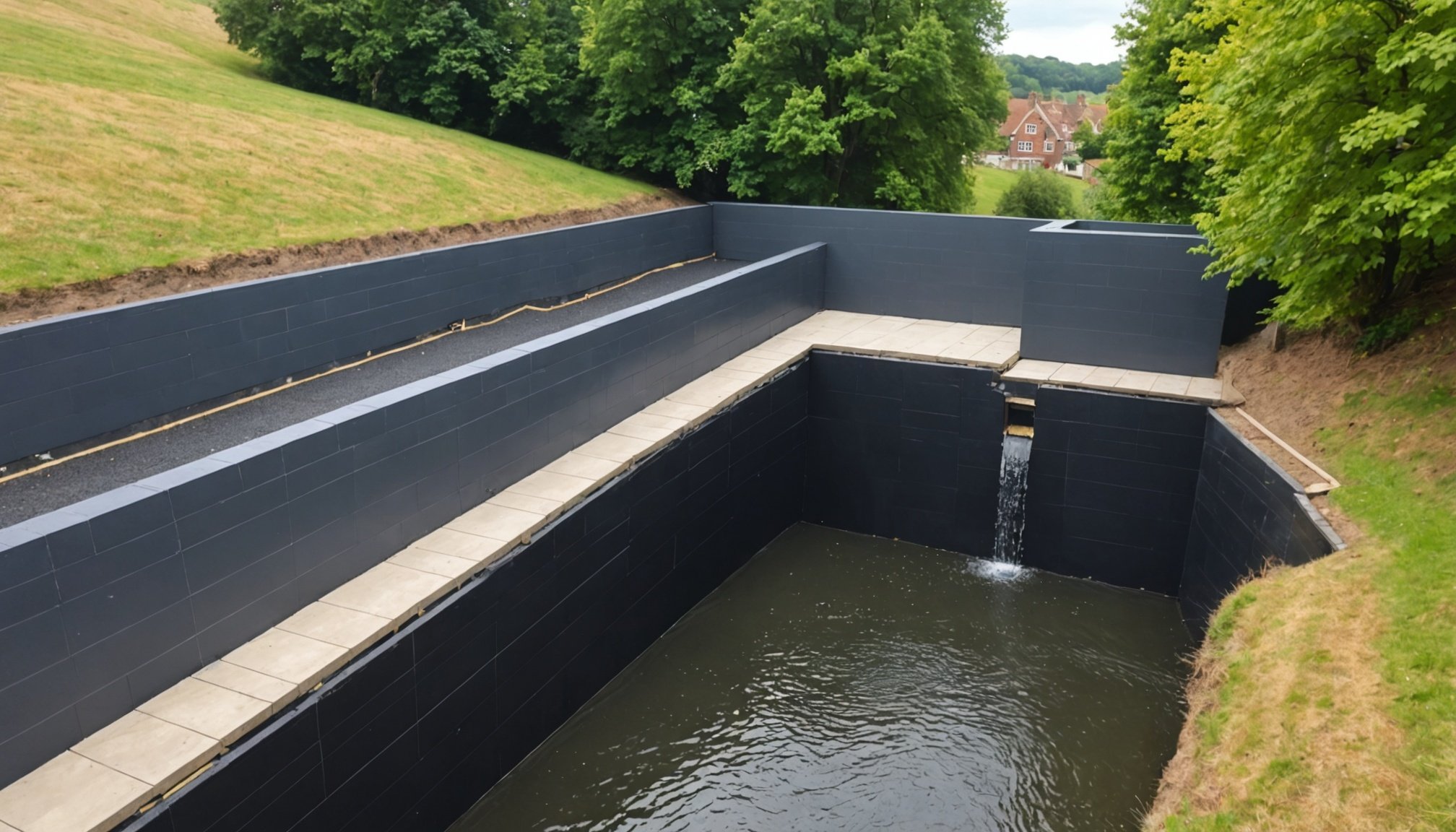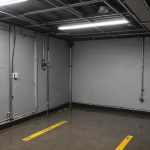Understanding the Unique Challenges of UK Hillside Homes
Owning a hillside home in the UK presents unique challenges that require careful consideration to prevent moisture-related issues. These properties, distinguished by their inclined positioning, often face significant drainage issues. This is due to water naturally flowing down the slope, which can result in water pooling around the foundation if not properly managed.
One of the most prevalent problems in hillside homes is the complication of moisture management. Without effective solutions, homes on slopes are particularly susceptible to water infiltration. This can lead to structural damage and the development of mould, impacting both the integrity and health of the living environment.
Dans le meme genre : Top Material Choices for a Long-lasting and Safe Playground Set in Your UK Suburban Garden
Proper drainage is critical in maintaining the waterproofing of hillside homes. Ensuring that water is efficiently redirected away from the home’s foundation safeguards against potential water damage. Some effective methods include the installation of French drains or the utilisation of retaining walls, which can channel excess water effectively.
Implementing a comprehensive water management strategy is essential for homeowners to mitigate these risks. By addressing these moisture management and drainage issues proactively, hillside homes can be preserved, maintaining their safety and value.
Sujet a lire : Essential Tips for Upkeeping Sash Windows in UK Conservation Areas: Best Practices Explained
Overview of Basement Waterproofing Methods
When seeking effective basement solutions, understanding the difference between external and internal waterproofing techniques is crucial. External waterproofing involves placing barriers on the foundation’s outside surface to block water completely, while internal waterproofing focuses on managing water penetration once it enters the basement.
External vs. Internal Waterproofing Techniques
External methods often include the application of moisture barriers or membranes directly to the exterior of the foundation. These waterproofing membranes are designed to resist water infiltration entirely. Internal methods may utilise sealants or coatings applied to basement walls to prevent moisture from seeping through porous surfaces.
Waterproofing Membranes and Their Types
There are several types of waterproofing membranes designed for different levels of protection. Liquid-applied membranes offer flexibility and complete coverage, while sheet membranes provide consistent thickness and are easy to install. Selecting the right membrane depends on specific basement needs and conditions.
Additional Basement Solutions
Sump pumps and drainage systems are vital in comprehensive basement waterproofing strategies. Sump pumps remove collected water from basements, preventing flooding, while drainage systems redirect water away from the foundation, reducing pressure and preventing seepage. Integrating these elements with effective waterproofing membranes ensures a dry and safe basement.
Cost Analysis for Waterproofing Solutions
Waterproofing costs can vary significantly based on the method chosen and the specific requirements of the site. It’s crucial to approach this with careful budgeting to ensure financial resources are allocated optimally.
When considering waterproofing a structure, especially in hilly areas, several factors can influence the costs. The type of soil, slope steepness, and local climate conditions are all significant. Materials like membranes and coatings may be more expensive due to the challenges of installation in uneven terrains. These factors necessitate tailored financial planning to accommodate potential extra expenses.
However, the upfront waterproofing costs should be seen as an investment. Effective waterproofing can prevent costly water damage over time, reduce maintenance costs, and enhance the durability of the structure. This translates to long-term financial benefits by preserving the property value and providing peace of mind.
The key is a balanced approach: thorough Initial budgeting and consideration of both immediate and future financial implications can lead to smart, cost-effective decisions.
Step-by-Step Installation Tips
Installing waterproofing solutions can be a straightforward process when you are armed with the right installation tips and materials. Beginning with a DIY approach requires certain essential tools: a waterproofing membrane, sealant, brushes, utility knife, measuring tape, and a roller. Acquiring high-quality tools ensures more reliable and durable outcomes.
To effectively execute DIY waterproofing, follow a few key steps. Start by thoroughly cleaning the area that requires waterproofing. An unclean surface can impede the effectiveness of the solution. Following this, accurately measure and cut the waterproofing membrane using your utility knife, fitting it snugly into the required space. Apply sealant generously but evenly around the edges to create a strong barrier against moisture ingress.
While DIY can be rewarding, there are scenarios where hiring professional services is prudent. Consider professional help when dealing with complex structures or large-scale projects, as their expertise guarantees precise and efficient application. They also ensure compliance with building regulations, providing peace of mind that the job is well-handled.
Overall, deciding between a DIY approach or engaging professionals depends largely on the scope of your project and your confidence in handling technical tasks.
Understanding Local Regulations and Compliance
Navigating the UK regulations for basement waterproofing requires comprehensive understanding and adherence to avoid potential pitfalls. Local building codes dictate specific requirements for waterproofing solutions, ensuring they meet safety and quality standards across municipalities. These codes often necessitate obtaining permits before any installation can proceed. Failing to comply with these requirements could result in fines or legal issues, something no homeowner wants to face.
Compliance is not just about adhering to laws—it’s about guaranteeing the safety and durability of your home. Accurate knowledge of local building codes is critical. They detail specifications such as the type of materials you can use and the methods of installation suitable for your area. This ensures that any waterproofing work not only withstands local environmental conditions but is also sustainable in the long term.
Obtaining the necessary permits is crucial. These permits signify that your planned work aligns with collected standards. Non-compliance can lead to penalties that might exceed initial waterproofing costs. Therefore, aligning your project with local regulations is an essential step towards a secure and legally compliant home renovation.
Recommended Products and Solutions
When considering waterproofing products for hillside homes, it is crucial to evaluate a range of effective solutions. Selecting the right materials can protect your property against water damage, a common issue for such terrains.
Highly-Rated Products
In the market, products like liquid rubber coatings and membrane systems, particularly polyurethane-based materials, receive high praise for their flexibility and resilience. They provide excellent water barriers, adapting to the natural settling of structures on inclines.
Pros and Cons of Materials
Liquid rubber is popular for its ease of application and strong adhesion to various surfaces. However, it might require more frequent inspections due to potential wear. Membrane systems, while costlier, offer long-term durability and are highly effective against water seepage.
Expert Recommendations
Experts suggest choosing a waterproofing system that aligns with the specific needs of your hillside home. This might include considering soil composition, climate, and the extent of exposure to water. It is advisable to consult with professional contractors to assess the best solutions tailored to your property’s unique characteristics, ensuring effective water management and longevity.
Case Studies and Success Stories
Understanding the impact of waterproofing through real-life examples can provide practical insights and confidence in its effectiveness. In the United Kingdom, hillside homes present unique challenges, and learning from their success stories is crucial.
One notable case study involves a series of households that successfully managed the risk of excess water damage through meticulously planned waterproofing projects. By implementing comprehensive waterproofing solutions, these homes avoided common pitfalls like dampness and structural compromise. Their strategy included assessing the landscape’s natural water flow and choosing suitable waterproof materials.
Lessons learned from these case studies underscore the importance of proper planning and selecting the right materials and techniques. For example, incorporating drainage systems effectively redirected water away from vulnerable areas, proving vital for preserving the homes’ integrity. Another critical lesson is the need for regular maintenance checks, ensuring that all waterproofing measures remain effective over time.
By focusing on these key elements, the impacts of well-implemented waterproofing solutions have extended home longevity significantly. These success stories not only serve as encouragement but also act as guides for homeowners facing similar issues. Learning from these experiences offers valuable knowledge, fostering confidence in adopting comprehensive waterproofing strategies.
Expert Insights and Interviews
Navigating waterproofing, especially in challenging terrains, demands more than just materials—it requires expert advice. Industry specialists agree that understanding the specific difficulties of a location, such as soil type and climatic conditions, is crucial for successful waterproofing. Their perspectives highlight the importance of preliminary assessments to tailor strategies effectively.
During interviews with seasoned professionals, they emphasised the necessity of choosing the right materials and technologies, particularly in complex terrains. Specialists frequently encounter errors like neglecting drainage systems or misjudging material compatibility, often leading to costly repair cycles. To avoid such pitfalls, they recommend thorough planning phases that include these considerations from the outset.
Diverse industry insights draw attention to the rapidly advancing waterproofing technologies that offer improved durability and efficiency. Professionals advocate for staying updated with these innovations to ensure optimal results. When implementing waterproofing solutions, it’s crucial to avoid complacency and regularly consult with experts to adapt to new methods and materials effectively.
If you’re embarking on a waterproofing project, remember these highlights from the experts: assess thoroughly, plan strategically, and continually update your materials knowledge. This expert-driven approach minimises errors and maximises waterproofing success.
Frequently Asked Questions
Addressing common concerns about basement waterproofing, we’ve compiled a list of frequently asked questions. Each question is crafted to reflect typical homeowner anxieties, offering expert answers to guide you.
What are the most prevalent signs that my basement needs waterproofing?
Look for visible water stains on walls, a persistent musty odour, or damp floors. These indicate potential water infiltration potentially caused by poor drainage or cracks in the foundation. By identifying these signs early, you can prevent further damage and address the issues effectively.
How can I choose the right waterproofing method?
Consider the specific causes of water intrusion in your basement. For surface-proofing needs, coating and sealing may be sufficient. However, for more severe issues, such as structural damage, you might need a comprehensive approach like exterior excavation or internal drain systems. Consulting with an expert can help tailor a solution that suits your needs and budget.
Where can I find additional resources for basement waterproofing?
To explore more information, homeowners can reach out to local contractors, attend home improvement workshops, or visit dedicated home maintenance websites. These resources provide insight and potentially connect you with seasoned professionals to address your waterproofing concerns.











